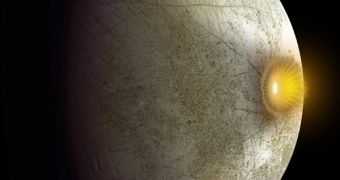A group of scientists with the NASA Jet Propulsion Laboratory (JPL), in Pasadena, California, says that a new analysis of data relayed back to Earth by the American space agency's Galileo spacecraft recently demonstrated the existence of clay-like minerals on the surface of the Jovian moon Europa.
The largest planet in our solar system features a large number of moons and other celestial bodies in orbit, but Europa is definitely one of the most interesting. In a recent study, for example, scientists determined that it might contain a liquid ocean underneath its icy surface, which may hold simple life.
The latest research suggests that a powerful impact between Europa and a space rock led to the accumulation or deposition of clay-like minerals on the moon's surface. The impactor may have been either an asteroid, or a comet, researchers say.
JPL investigators say that this is the first time when this type of minerals has been discovered on the surface of Europa. What is very interesting about this study is that it suggests the presence of organic materials as well, since the type of space rocks that deposits these clays usually carries organic molecules as well.
Details of the research will be presented tomorrow, December 13, at the annual meeting of the American Geophysical Union (AGU), which is being held in San Francisco, California.
“Organic materials, which are important building blocks for life, are often found in comets and primitive asteroids. Finding the rocky residues of this comet crash on Europa's surface may open up a new chapter in the story of the search for life on Europa,” says JPL research scientist Jim Shirley.
The images that enabled the research team to discover the clay-type minerals were collected by the Galileo spacecraft back in 1998. By carefully analyzing these photos, scientists led by Shirley were able to find signs of minerals called phyllosilicates.
One of the reasons why the team believes an ancient impact occurred is that these minerals are scattered in a broken ring about 40 kilometers (25 miles) wide, which is itself located around 120 kilometers (75 miles) away from a central crater site.
The team believes the first formation was crated via splash back of material ejected following the main impact of an asteroid or comet to Europa's surface. The central crater site is around 30 kilometers (20 miles) in diameter.
“Understanding Europa's composition is key to deciphering its history and its potential habitability. It will take a future spacecraft mission to Europa to pin down the specifics of its chemistry and the implications for this moon hosting life,” says JPL investigator Bob Pappalardo, who is a scientists on a proposed project to build a mission aimed at studying Europa.

 14 DAY TRIAL //
14 DAY TRIAL //